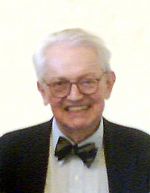Charles Pence Slichter facts for kids
Quick facts for kids
Charles Pence Slichter
|
|
|---|---|
 |
|
| Born | 21 January 1924 |
| Died | 19 February 2018 (aged 94) |
| Alma mater | Harvard University (AB magna cum laude 1946, MA 1947, PhD 1949, honorary LlD 1996) |
| Known for | J-coupling, Overhauser effect, Hebel-Slichter effect |
| Awards | National Medal of Science (2007) Oliver E. Buckley Condensed Matter Prize (1996) Comstock Prize in Physics (1993) Irving Langmuir Award (1969) |
| Scientific career | |
| Fields | Physics |
| Institutions | University of Illinois at Urbana-Champaign |
| Doctoral advisor | Edward Purcell |
Charles Pence Slichter (January 21, 1924 – February 19, 2018) was an American physicist. He was famous for his important work on nuclear magnetic resonance (NMR) and superconductivity.
In 2007, he received the National Medal of Science. This award recognized him for making NMR a powerful tool. It helped scientists understand the basic properties of liquids and solids. His teaching also inspired many physicists and chemists. They went on to create new technologies in physics, chemistry, biology, and medicine.
Contents
Early Life and Education
Charles Slichter was born in 1924 in Ithaca, New York. He went to Harvard University. In 1949, he earned his Ph.D. (a high-level degree) there. His main teacher and guide was Edward Mills Purcell.
A Career in Science
Slichter became a professor of physics and chemistry. He taught at the University of Illinois at Urbana-Champaign from 1949 until he retired in 2006.
During a break from teaching in 1961, he gave special lectures at Harvard University. These lectures later became the basis for his famous book, "Principles of Magnetic Resonance."
Slichter also helped guide science in the United States. He was a member of the National Science Board from 1976 to 1984. He also served on the President's Science Advisory Committee from 1965 to 1969. He even helped choose the president of Harvard University in 1991. He was a member of important groups like the National Academy of Sciences.
Amazing Discoveries
Slichter's main research focused on NMR and superconductivity. These are two big areas in physics.
Some of his most important discoveries include:
- He helped discover the Hebel-Slichter effect. This gave early proof for the BCS theory of superconductivity. This theory explains how some materials can conduct electricity with no resistance.
- With Tom Carver, he was the first to show how the Overhauser Effect works. This effect is used in chemistry and biology to study molecules.
- With Herbert S. Gutowsky and McCall, he found something called J-coupling. This is important for understanding how atoms connect in molecules.
- With Bob Schumacher and Tom Carver, he made the first measurement of a special property of electrons called Pauli spin susceptibility.
He also made other important contributions. He found ways to detect very weak signals in NMR. He studied charge density waves and the Kondo effect. He also looked at how chemical shifts work and studied high-temperature superconductivity. His work even helped understand how chemicals react on metal surfaces, which is important for catalysis.
Slichter received many awards for his work. Besides the National Medal of Science, he won the Comstock Prize in Physics in 1993. In 1969, he got the Langmuir Prize. In 1996, he received the Buckley Prize. In 2016, the American Chemical Society honored him for discovering J-coupling.
He also received honorary degrees from several universities, including Harvard University.
His Family
Charles Slichter came from a family of smart people. His father, Sumner Slichter, was an economist. His grandfather, Charles S. Slichter, was a mathematician. His uncle, Louis B. Slichter, was a geophysicist. His son, Jacob Slichter, is a musician. His brother, William P. Slichter, worked as an executive at Bell Labs.
Books He Wrote
- Slichter, Charles Pence (1963). Principles of magnetic resonance: with examples from solid state physics. (1st ed.). Harper & Row. ISBN 9783540084761. https://archive.org/details/principlesofmagn0000slic.
- Slichter, Charles Pence (1978). Principles of magnetic resonance: Second revised and expanded edition (2nd ed.). Springer. ISBN 9780387084763. https://archive.org/details/principlesofmagn0000slic_r4m9.
- Slichter, Charles Pence (1990). Principles of magnetic resonance: Third enlarged and updated edition (3rd ed.). Springer. ISBN 9783540501572. https://www.springer.com/us/book/9783540501572.
See also
 In Spanish: Charles Pence Slichter para niños
In Spanish: Charles Pence Slichter para niños

